A Conversation with Joakim Eskildsen
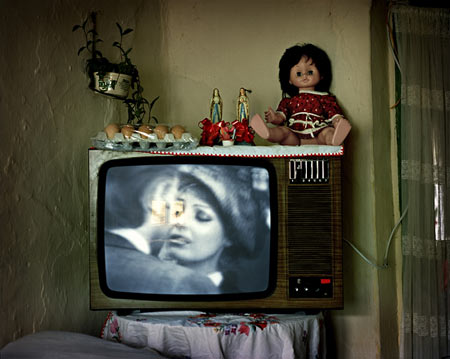
Joakim Eskildsen has just had “The Roma Journeys” published (see my review here), the culmination of years of photographic work. I was very interested in talking to Joakim about the project, and he kindly agreed to share his experience.
Jörg Colberg: Your “The Roma Journeys” is a big project, done over several years, with significant amounts of time dedicated to traveling and staying in various countries. The results are well worth the effort - but how hard is it really for a photographer to go about such an immense project?
Joakim Eskildsen: There are so many stages of doing this work. I never thought that it was very hard as this was somehow the only way we could do it, so we had no choice. One thing led to the next, and I enjoyed the process a lot and wanted to continue, as it was such a great stage to be in the middle of a process where everything is possible; you can do this or that, everything is open. What I found harder was the decision to say ‘now it’s enough, let’s stop collecting material and start looking at it’. That is much more scaring as you sort of see the truth, what you have there, and it is much more realistic. I feel in the same way with contact sheets: it is always slightly nerve-consuming to look at them, I prefer thinking about the pictures I took than seeing them on these contact sheets where everything is so technical and maybe not at all as I remember. Then the hard work of working on the photographs begins. While creating the images, I live a bit like in a dream world, imagining the book, and that stage is very beautiful, you can continue going on - changing here, making more of this kind of pictures - but once we finally decided that it was enough, I started working only on the material.
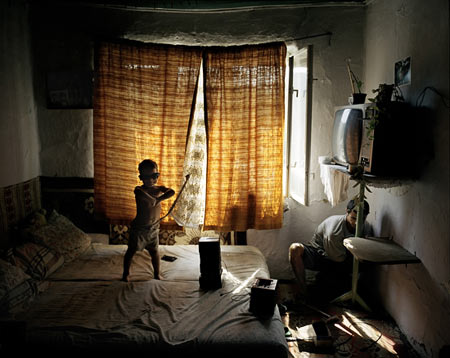
Staying with other people during longer times, you have to put your own needs and habits aside and fit into the place you live in, which is something that is always difficult at first. Sometimes, we almost had a breakdown because of lack of privacy, but there were always so many positive things that we felt encouraged to continue, and after all, it is also one of the most interesting aspects of working like this to have to break your own habits and live yourself into other ways of life.
The project was realized over many years, so there were many small hills to climb. Also, in many ways, it is about being patient, and not thinking too far ahead in the future, but just putting your energy on this little hill you are just climbing, and still keeping in mind the idea of the book you will make at some point of time. During the process, it seemed like the time just flew away, and I had the feeling that we only worked very shortly on this. I still feel that I am not finished with the theme.
One huge work is also just to make it possible financially. Cia and I spent many weeks every year trying to raise the money needed to continue working on the project. We have been very lucky, I have hardly done anything else during the last seven years, so it worked nicely. We were (are) not rich, and always tried to live on an absolute minimum on all levels; living in a very old house with a reasonable rent in Finland made it possible to stay away from home even for longer periods. We simply worked very intensively, and in a way, this was the absolutely shortest time needed to do this work.
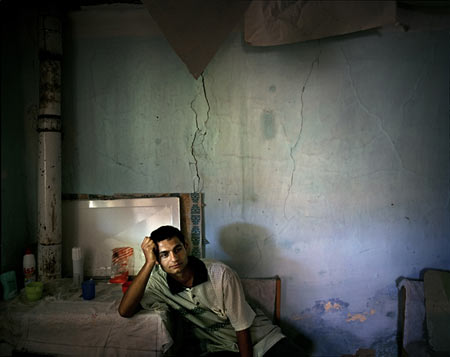
JC: Having done such a vast project would you do something like this again? Or do you envision smaller projects in the future?
JE: One has to sort of grow with one’s projects, and then use the time needed, but I can see now that I have a little child and will have another in a few months, I simply do not have the possibility to work on such an intense and time-consuming project, lasting for so long. At this moment, I need to give away quite some of my energy and time to my children. Of all the projects I have done so far, I feel that the Roma Journeys were the most involving and intense, and we went very deep into the subject. It became the main thing in our lives for the last seven years. Besides the photographing aspect, it is also very interesting intellectually, and it required a long time to understand things. I am hoping though that in ten years from now, I will be working on another long-term project. In the meanwhile, I do also need to sort of recover from this long work, and right now, I feel like working on smaller and quicker projects. Many things have been put on hold during this work. Anyhow, collecting negatives is always a long-term thing for me, so there are several themes; I will look into my archive for images, they might be 10-15 years old, but it is a very different matter than working on an intensive project exclusively on a certain topic. If one is lucky to live a long life, I hope to be able to make two more projects in the way as the Roma Journeys were done.
JC: Did you find that your photography changed over the course of the years, while you were working on “The Roma Journeys”?
JE: I am not sure if I changed or the places and people changed, or both, but something changed even though it is not much. I think you are in a better position to see this?
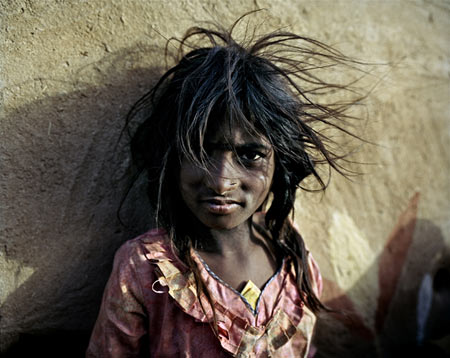
JC: This might be a bit hard to see, since there also is the difference in the locations. I’m curious about whether you think your photography depended on where you were. When looking through the book, I noted that each country appears to have slightly different photography. There clearly is the same photographer at work, but it appears you might have been more comfortable in some countries than in others? Maybe my impression is mistaken?
JE: It is strange how every chapter and country got its own style. In Finland, I was photographing just next to were we lived. A certain color turned up, gray and blue, which I liked, and this inspired me to take more such pictures, and in a similar way, every country had something special that inspired me and made the chapter in the book look different. In the editing, I tried to make this difference clear, too. I can maybe say that Finland was the chapter that needed most effort and time. In Russia and France, we spent the shortest time, but I felt very inspired, and have an enormous amount of material from these places. France and Greece we only visited once, for about two months though, whereas we worked in the other countries during several stays. It is very inspiring to me to push myself out in different circumstances, and this affects my way of working. I also have a ‘mantra’ or idea, e.g. in earlier works, I never used to photograph when there was a blue sky or when people were laughing. I usually have some strange dogmas and limits when working on a theme. Looking at earlier pictures, I could see for instance that it would be interesting to lift this barrier and to say to myself, ‘blue sky is beautiful’, and in this way, I would direct myself so that while photographing, I just reacted, and suddenly I was able to photograph blue sky. I love the feeling that I am able to challenge myself and to change. Even though these changes are minor, they are of major importance to my work.
JC: But there was never any period where you felt uncomfortable with where you were? Or with maybe the circumstances? Did you ever seriously question the project?
JE: Of course, I question everything almost all the time! Anxiety and a pain in the stomach always accompany the beginning of a journey. As soon as I have gotten used to the surroundings and met good people though, I start to relax and can concentrate on my work. Usually, at the end of all our journeys, we felt extremely happy and inspired, and wanted to continue.
In general, one aspect that often drove Cia and me crazy was that we were so often dependent on others’ program and rhythm. In order to get that close to people, there is not other way, and this is what made the time spent with the people so special, but at times, I simply had enough and longed for some privacy; that always happens when you live with other people for some time. You need to have enormous patience and openness, which is of course true for the people we stayed with, too.
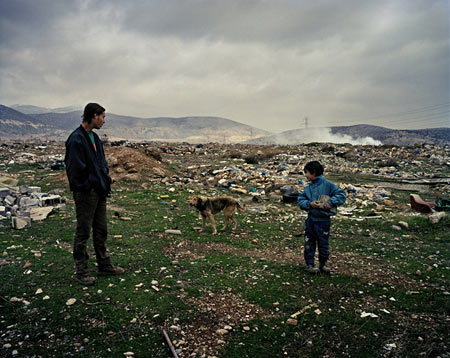
In Greece, we were sleeping in a shack, and the people we stayed with insisted they would sleep on the floor, and this made us feel uncomfortable. If we felt we caused trouble, we tried to find another place as near as possible. Naturally, nothing is easy when health is not, and in India for instance, Cia and I both fell sick, and had to go to hospital. At the time Cia got a fever, we were in a very remote place where it was difficult to get any help. The local doctor simply did not do us any good, and it was a long way back to the city. We always used public transport, and walked on foot, and at times, we would end up in places where we should not be, but we simply had to stay because there was no possibility to get away again like once in Mironu in Romania where we were surrounded by hundreds people until late night, which was hard and tiresome.
Basically, I am not very brave, and I could never photograph in war zones, for example. I like quiet villages where nothing especially dangerous is going on. I am aware that many of the places we stayed at are considered dangerous, but we did not feel that.
JC: Editing is one of those aspects of photography that is hardest to do. Given the sheer number of photos in the book, I cannot even imagine how many others you must have rejected. How does one go about editing such a vast project?
JE: The way I went about working on “The Roma Journeys” was that of all the film I took on each journey, I would make contact sheets that I spent weeks studying. I would then mark out all pictures that were of interest, and scan them in a small resolution to make a quick fine- looking file. Then I printed all of them in the size of 6x7 cm and cut them out, so I ended up with a bunch of ‘cards’. These bunches of pictures I used a lot as they look like fine prints, and I worked a lot with them, combining pictures and simply putting aside the ones which did last. I must have several thousands of these small prints. Along the way, we would make sketchbook (at bottom), and these books we carried with us, showing virtually to everybody we met. Looking over the shoulders while other people were studying the sketchbooks, I got a very strong feeling of which picture should be taken away and which not. So these books were then all the time updated and rearranged back and forth along with the new material, which would every time change the editing of the earlier sketchbooks. For making the final edition and layout of the book, I saw two good friends, the photographer Jyrki Parantainen, who is very good at telling his honest opinion that I trust a lot. I would work weeks and months on the combinations, the flow and rhythm of the book, and at some stage, although I felt it was not there yet, I was totally blind and did not know how to go on. Together with Jyrki, we took several sessions of 2-3 days going through the book, cutting, changing, and then having a long break before going through the material at a later point of time again. At one point, I had some 500 pictures in the book, all of which had gone through my showing test, and I felt they all would last, but it was simply too heavy to go through so many pictures in a book. In the end of the India chapter, I for instance had three pictures with the same brown-reddish color feeling, and it simply killed the rhythm and made the chapter weak. In such a thick book, you cannot have similar kind of pictures from each country. Even though all would be good, we simply had to put all the similar pictures next to each other and choose only one. We turned each chapter many times and cut out everything that disturbed the flow or made you loose interest and focus. We had the idea that it would be better that, after going through the book, one would have the feeling of wanting to see more instead of -as was the case when I had 500 pictures in the book- thinking ‘finally, the end!’. It should be as airy as possible, and one step in pursuing this was making more pages with just one picture on a double spread, leaving one page blank. I of course worked a lot on finding pictures that would match on a double spread, using the criteria of color, light and content. Also, I tried to make one color slide over to a similar color, or at least to having the same color in some little spot on the facing page. At some point of working on the book layout, it felt as if that was it now, there could be no more changes. So I started rescanning the chosen pictures and making the final good prints. I made hundred big exhibitions prints. At that stage, I was a bit nervous since I had not seen a single print bigger than 6x7 cm for six years, and I was worried whether they would work as larger fine prints, too. The exhibition prints are 75x90 cm, and they work just fine.
I feel that the typography, the size and the whole form of the book are as much part of the work as the actual photographs. My friend Jouko Ollikainen, who is a graphic designer, was the main critic concerning the design of the book. I would proceed in the same way as when editing the pictures, and once in a while show the layout to Jouko to hear his opinion. I am very interested in typography, and planning the layout and grid of the book was a long process, too. The sketchbooks were my testing fields. I believe it is very important to find somebody you can discuss with and go crazy about the details together. In the end, you have to make all the final decisions yourself, but I could not have taken them without getting good criticism. While showing the book to Gerhard Steidl who has an extremely sharp eye, the only change he asked for was making the text layout a little more airy, which was a very good idea. The very last details were done with him.

JC: I’m curious as to whether (and how) the collaboration with Cia shaped your photography?
JE: Cia and I have worked together since 1995, and our first book Bluetide was published in 1997. Cia speaks many languages, and is in many ways my opposite. She studied philosophy and has published works of concrete poetry. We share a common interest in the world and the work we do though, and simply like to spend time together. She has a different approach to the Roma project, and has studied all she could find, as did I along with her, although in a lesser degree. Her interest and approach opened many new doors to me. All this changes your way of thinking, and by that, also of seeing. It is certain that I would never ever have done this project alone just as Cia would not have done so, as it is very much two people’s best strings put together that made it possible to realize it. In a very practical way, while working, sometimes when we went to see somebody Cia wanted to talk to, I hung around, and sometimes something caught my interest. In a similar way, when I visited a house to photograph something, Cia would start talking to somebody. So, working together was helping us both in what we trying to do. It maybe also feels less dangerous for people to invite a couple inside than a single man. The photographs are a result of a long chain of things, and I am sure that the collaboration with Cia has shaped me a lot. It has given me access to situations that would otherwise have been very unlikely. Again, this is very hard for me to see and separate. It is very inspiring to do something like this together as you can discuss and criticize each other in a way you normally could not.
JC: And then, what is next? Is there a big void to be filled after having finished this big project, or is there already new work being done?
JE: After each of the earlier books, I was very low and down for some time, but this time, I tried to warm up for other things before finishing the project to try avoiding that emptiness. I was almost scared of finishing the Roma project, as it had been such a great feeling to go on working on it. Right now, I am working on several things. Firstly, I for many years took pictures around the old house in Finland we used to live in, and these pictures I have just made contact sheets of. I am planning to make some little book from this material. When I moved to Denmark in August 2007, I started to photograph around the place I grew up in. I lived in Finland for 13 years, and visited Denmark only rarely during that time, so it is interesting to explore the area now. I have not made any prints as yet, but just been taking films and imagining what might be on them. I like the idea of making a year’s pictures, and not looking at the films before a long time has passed. Cia and I will have our second child soon, and I plan I to photograph something just around our house for some time, as I like to be together with my family. Right now, during the past weeks, I have tried something totally new to me, a commissioned job for an architectural magazine that asked me to document seven different planned towns or settlements in Europe, spending two days photographing in each place. They asked Cia to make the text, and our 2-year old son was with us. It is something I wanted to test to see how it would work to do such things, and I cannot tell how it will turn out as I am still in the middle of it. On a long-term perspective, I would like to continue working with the Roma, but I think I make a break until our children are a little older, so they can come along. I am so lucky to have a 3-year artist grant, so I am not planning on working on other things than my own, and one needs a lot of time to experiment and to see where life takes you.
 By
By